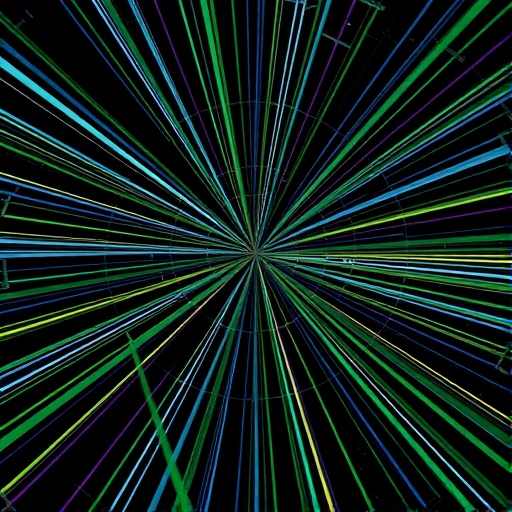In the rapidly evolving field of imaging science, coherent diffraction imaging (CDI) has emerged as a powerful technique allowing researchers to probe the microscopic world with unprecedented resolution. Recently, a groundbreaking advancement presented by Sheng and Zhang in the journal Light: Science & Applications has pushed the boundaries of this technology further, unveiling a novel approach termed serial coherent diffraction imaging of dynamic samples based on inter-frame continuity. This method not only addresses the persistent challenge of imaging highly dynamic specimens but also opens new horizons for capturing transient states with remarkable precision.
Traditional CDI relies on the coherent interference patterns of scattered waves from a static object to reconstruct its spatial structure. However, imaging dynamic samples presents a formidable challenge because any motion or structural evolution during data acquisition can degrade the quality of the diffraction patterns, resulting in blurred or inaccurate reconstructions. Sheng and Zhang’s innovative approach cleverly circumvents this limitation by leveraging the continuity that exists between successive frames in a time series, employing serial imaging tactics that continuously track evolving samples with minimal information loss.
At the core of this transformative technique is the concept of inter-frame continuity, which essentially exploits the inherent temporal correlation between successive diffraction patterns captured in rapid sequence. By acknowledging and mathematically encoding the relationship of spatial features as they morph between frames, the method achieves a significant enhancement in reconstruction stability and fidelity. This temporal coherence strategy minimizes the error accumulation typically observed in traditional CDI approaches when dealing with moving objects, thus facilitating the reconstruction of high-resolution images in conditions formerly considered prohibitive.
The implications of this development resonate profoundly across various scientific and industrial domains. In materials science, for instance, the ability to visualize phase transitions or deformation processes in real time at the nanoscale could accelerate the design of advanced materials with tailored properties. Similarly, in biological imaging, deciphering the fast structural dynamics of macromolecules or cellular components could elucidate fundamental mechanisms underpinning life processes, potentially driving novel therapeutic strategies.
Methodologically, Sheng and Zhang integrate sophisticated algorithms capable of utilizing temporal continuity as a constraint during phase retrieval, a notoriously challenging step in CDI. This phase retrieval process, critical for reconstructing spatial information from diffraction intensities, typically suffers from ambiguity and noise sensitivities. The introduction of temporal constraints effectively regularizes the solution space, guiding the iterative reconstruction procedure toward consistent and physically meaningful results over time.
Furthermore, the serial coherent diffraction imaging framework incorporates an experimental setup optimized for rapid acquisition of diffraction frames, ensuring minimal temporal gaps between subsequent exposures. This high frame rate capture synergizes with advanced data processing techniques, forming a cohesive system adept at chronicling dynamic structural phenomena with unprecedented time resolution, without compromising spatial detail.
In validating their approach, the researchers implemented the technique on samples exhibiting controlled dynamic behaviors, demonstrating marked improvements in image clarity and accuracy compared to conventional CDI methods. These proof-of-concept experiments underscore the robustness of the novel method in practical scenarios, showcasing its potential as a versatile tool adaptable to diverse scientific challenges involving dynamic specimens.
Beyond mere imaging improvements, this breakthrough paves the way for exploring phenomena that have so far remained elusive due to temporal limitations in measurement. For example, observing transient intermediate states in chemical reactions, rapid morphological changes in nanostructures, or the swift conformational shifts in protein complexes becomes realistically achievable under this enhanced CDI regime.
The fusion of coherent diffraction data with temporal continuity constraints exemplifies an emerging paradigm in imaging sciences where multidimensional correlations—spatial, temporal, and possibly spectral—are jointly harnessed to unlock richer information content. This integrative approach not only ensures higher fidelity reconstructions but also fosters new algorithmic developments tailored for exploiting inherent sample dynamics.
Importantly, the technique’s compatibility with existing CDI instrumentation signals a relatively straightforward pathway to adoption within the scientific community. Laboratories already equipped with coherent light sources and detectors can implement the serial imaging protocol with software upgrades and optimized data acquisition schemes, thus democratizing access to dynamic imaging capabilities.
Despite these promising advances, challenges remain to be addressed in scaling this method for broader applications. Handling extremely rapid or nonlinear sample dynamics, mitigating cumulative radiation damage during prolonged observations, and managing the vast data throughput generated during serial acquisitions require ongoing innovation in hardware and computational strategies.
Nevertheless, Sheng and Zhang have laid a compelling foundation for future exploration, inspiring a new avenue where time-resolved coherent diffraction imaging could become a mainstay technique for studying rapid processes at the nanoscale. Their work epitomizes the synergy between experimental ingenuity and algorithmic sophistication, underpinning the rapid evolution of microscopy techniques essential for deciphering the complexities of dynamic matter.
In conclusion, the introduction of serial coherent diffraction imaging based on inter-frame continuity ushers in a new era for dynamic sample analysis, offering a potent combination of temporal resolution and structural insight. As this technology matures, it promises to transform the investigative landscape across disciplines ranging from physics and chemistry to biology and materials science. Through capturing the ever-changing microscopic world with greater clarity, we edge closer to unlocking the transient secrets that drive the functionality of complex systems.
As researchers continue to refine and expand upon this innovative methodology, the broader scientific community eagerly anticipates a renaissance in real-time imaging capabilities. The profound impact of Sheng and Zhang’s approach not only redefines the limits of spatial and temporal resolution but also charts a course towards more comprehensive and nuanced understanding of dynamic phenomena at the atomic and molecular scales.
Subject of Research: Serial coherent diffraction imaging and dynamic sample analysis
Article Title: Serial coherent diffraction imaging of dynamic samples based on inter-frame continuity
Article References:
Sheng, P., Zhang, F. Serial coherent diffraction imaging of dynamic samples based on inter-frame continuity. Light Sci Appl 14, 230 (2025). https://doi.org/10.1038/s41377-025-01860-8
Image Credits: AI Generated




